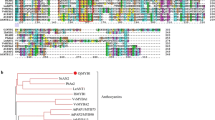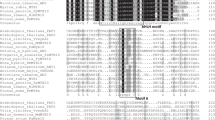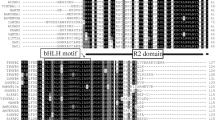Key message
A R2R3-MYB transcription factor EsAN2 was isolated from Epimedium sagittatum and functionally characterized to regulate the anthocyanin biosynthetic pathway.
Abstract
Epimedium plants are used widely both as traditional Chinese medicinal herbs and ornamental perennials. Anthocyanins, acting as major contributors to plant color diversity, their biosynthesis are regulated by a series of transcription factors, including MYB, bHLH and WD40 protein. Previously, a MYB transcription factor involved in regulation of the anthocyanin pathway from Epimedium sagittatum, EsMYBA1 has been isolated, but was found to be expressed mostly in leaves. In this research, another MYB transcription factor, designated as EsAN2, was isolated from flowers by the screening of E. sagittatum EST database. Preferential expression of EsAN2 in flowers and flower buds was found. Ectopic expression of EsAN2 in tobacco significantly enhanced the anthocyanin biosynthesis and accumulation, both in leaves and flowers. Most structural genes of the anthocyanin biosynthetic pathway were strongly upregulated, as well as two bHLH regulators (NtAn1a and NtAn1b) in old leaves of tobacco overexpressing EsAN2, compared to the control plants. While only three structural genes, chalcone synthase (CHS), chalcone isomerase (CHI) and anthocyanidin synthase (ANS), were upregulated by EsAN2 ectopic expression in tobacco flowers. Yeast two-hybrid assay showed that EsAN2 was capable of interacting with four bHLH regulators of the anthocyanin biosynthetic pathway. These results suggest that EsAN2 is involved in regulation of the anthocyanin biosynthesis in Epimedium flowers. Identification and characterization of EsAN2 provide insight into the coloration of Epimedium flowers and a potential candidate gene for metabolic engineering of flavonoids in the future.







Similar content being viewed by others

References
Aharoni A, De Vos C, Wein M et al (2001) The strawberry FaMYB1 transcription factor suppresses anthocyanin and flavonol accumulation in transgenic tobacco. Plant J 28:319–332
Allan A, Hellens R, Laing W (2008) MYB transcription factors that colour our fruit. Trends Plant Sci 13:99–102
Bai Y, Pattanaik S, Patra B, Werkman JR, Xie CH, Yuan L (2011) Flavonoid-related basic helix-loop-helix regulators, NtAn1a and NtAn1b, of tobacco have originated from two ancestors and are functionally active. Planta 234:363–375
Ban Y, Honda C, Hatsuyama Y, Igarashi M, Bessho H, Moriguchi T (2007) Isolation and functional analysis of a MYB transcription factor gene that is a key regulator for the development of red coloration in apple skin. Plant Cell Physiol 48:958–970
Borevitz JO, Xia Y, Blount J, Dixon RA, Lamb C (2000) Activation tagging identifies a conserved MYB regulator of phenylpropanoid biosynthesis. Plant Cell 12:2383–2393
Chen J, Xu Y, Wei G et al (2015) Chemotypic and genetic diversity in Epimedium sagittatum from different geographical regions of China. Phytochemistry 116:180–187
Czemmel S, Heppel S, Bogs J (2012) R2R3 MYB transcription factors: key regulators of the flavonoid biosynthetic pathway in grapevine. Protoplasma 249:109–118
Dubos C, Stracke R, Grotewold E, Weisshaar B, Martin C, Lepiniec L (2010) MYB transcription factors in Arabidopsis. Trends Plant Sci 15:573–581
Elomaa P, Uimari A, Mehto M, Albert V, Laitinen R, Teeri T (2003) Activation of anthocyanin biosynthesis in Gerbera hybrida (Asteraceae) suggests conserved protein–protein and protein-promoter interactions between the anciently diverged monocots and eudicots. Plant Physiol 133:1831–1842
Espley RV, Hellens RP, Putterill J, Stevenson DE, Kutty Amma S, Allan AC (2007) Red colouration in apple fruit is due to the activity of the MYB transcription factor, MdMYB10. Plant J 49:414–427
Feller A, Machemer K, Braun EL, Grotewold E (2011) Evolutionary and comparative analysis of MYB and bHLH plant transcription factors. Plant J 66:94–116
Gonzalez A, Zhao M, Leavitt JM, Lloyd AM (2008) Regulation of the anthocyanin biosynthetic pathway by the TTG1/bHLH/Myb transcriptional complex in Arabidopsis seedlings. Plant J 53:814–827
Grotewold E (2006) The genetics and biochemistry of floral pigments. Annu Rev Plant Biol 57:761–780
Harborne JB, Williams CA (2000) Advances in flavonoid research since 1992. Phytochemistry 55:481–504
Hichri I, Barrieu F, Bogs J, Kappel C, Delrot S, Lauvergeat V (2011) Recent advances in the transcriptional regulation of the flavonoid biosynthetic pathway. J Exp Bot 62:2465–2483
Hodges SA, Derieg NJ (2009) Adaptive radiations: from field to genomic studies. Proc Natl Acad Sci USA 106:9947–9954
Holton T, Cornish E (1995) Genetics and biochemistry of anthocyanin biosynthesis. Plant Cell 7:1071–1083
Horsch R, Fry J, Hoffmann N, Eichholtz D, Rogers SG, Fraley R (1985) A simple and general method for transferring genes into plants. Science 227:1229–1231
Huang W, Sun W, Lv H et al (2013) A R2R3-MYB transcription factor from Epimedium sagittatum regulates the flavonoid biosynthetic pathway. PLoS One 8:e70778
Jaakola L (2013) New insights into the regulation of anthocyanin biosynthesis in fruits. Trends Plant Sci 18:477–483
Jin H, Martin C (1999) Multifunctionality and diversity within the plant MYB-gene family. Plant Mol Biol 41:577–585
Jin H, Cominelli E, Bailey P et al (2000) Trancriptional repression by AtMYB4 controls production of UV-protecting sunscreens in Arabidopsis. EMBO J 19:6150–6161
Kobayashi S, Goto-Yamamoto N, Hirochika H (2004) Retrotransposon-induced mutations in grape skin color. Science 304:982
Koes R, Verweij W, Quattrocchio F (2005) Flavonoids: a colorful model for the regulation and evolution of biochemical pathways. Trends Plant Sci 10:236–242
Laitinen RAE, Ainasoja M, Broholm SK, Teeri TH, Elomaa P (2008) Identification of target genes for a MYB-type anthocyanin regulator in Gerbera hybrida. J Exp Bot 59:3691–3703
Lubell JD, Brand MH (2005) Division size and timing influence propagation of four species of Epimedium L. HortScience 40:1444–1447
Ma H, He X, Yang Y, Li M, Hao D, Jia Z (2011) The genus Epimedium: an ethnopharmacological and phytochemical review. J Ethnopharmacol 134:519–541
Niu S-S, Xu C-J, Zhang W-S et al (2010) Coordinated regulation of anthocyanin biosynthesis in Chinese bayberry (Myrica rubra) fruit by a R2R3 MYB transcription factor. Planta 231:887–899
Pattanaik S, Kong Q, Zaitlin D, Werkman JR, Xie CH, Patra B, Yuan L (2010) Isolation and functional characterization of a floral tissue-specific R2R3 MYB regulator from tobacco. Planta 231:1061–1076
Peel GJ, Pang Y, Modolo LV, Dixon RA (2009) The LAP1 MYB transcription factor orchestrates anthocyanidin biosynthesis and glycosylation in Medicago. Plant J 59:136–149
Petroni K, Tonelli C (2011) Recent advances on the regulation of anthocyanin synthesis in reproductive organs. Plant Sci 181:219–229
Quattrocchio F, Wing J, van der Woude K, Souer E, de Vetten N, Mol J, Koes R (1999) Molecular analysis of the anthocyanin2 gene of petunia and its role in the evolution of flower color. Plant Cell 11:1433–1444
Ramsay NA, Glover BJ (2005) MYB-bHLH-WD40 protein complex and the evolution of cellular diversity. Trends Plant Sci 10:63–70
Spelt C, Quattrocchio F, Mol JNM, Koes R (2000) anthocyanin1 of petunia encodes a basic helix-loop-helix protein that directly activates transcription of structural anthocyanin genes. Plant Cell 12:1619–1631
Stracke R, Werber M, Weisshaar B (2001) The R2R3-MYB gene family in Arabidopsis thaliana. Curr Opin Plant Biol 4:447–456
Takos AM, Jaffé FW, Jacob SR, Bogs J, Robinson SP, Walker AR (2006) Light-induced expression of a MYB gene regulates anthocyanin biosynthesis in red apples. Plant Physiol 142:1216–1232
Tamagnone L, Merida A, Parr A, Mackay S, Culianez-Macia F, Roberts K, Martin C (1998) The AmMYB308 and AmMYB330 transcription factors from antirrhinum regulate phenylpropanoid and lignin biosynthesis in transgenic tobacco. Plant Cell 10:135–154
Tamura K, Peterson D, Peterson N, Stecher G, Nei M, Kumar S (2011) MEGA5: molecular evolutionary genetics analysis using maximum likelihood, evolutionary distance, and maximum parsimony methods. Mol Biol Evol 28:2731–2739
Thompson JD, Higgins DG, Gibson TJ (1994) CLUSTAL W: improving the sensitivity of progressive multiple sequence alignment through sequence weighting, position-specific gap penalties and weight matrix choice. Nucleic Acids Res 22:4673–4680
Tian J, Peng Z, Zhang J, Song T, Wan H, Zhang M, Yao Y (2015) McMYB10 regulates coloration via activating McF3′H and later structural genes in ever-red leaf crabapple. Plant Biotechnol J 13:948–961
Tohge T, Nishiyama Y, Hirai MY et al (2005) Functional genomics by integrated analysis of metabolome and transcriptome of Arabidopsis plants over-expressing an MYB transcription factor. Plant J 42:218–235
Vimolmangkang S, Han Y, Wei G, Korban S (2013) An apple MYB transcription factor, MdMYB3, is involved in regulation of anthocyanin biosynthesis and flower development. BMC Plant Biol 13:176
Walker AR, Lee E, Bogs J, McDavid DAJ, Thomas MR, Robinson SP (2007) White grapes arose through the mutation of two similar and adjacent regulatory genes. Plant J 49:772–785
Winkel-Shirley B (2001) Flavonoid biosynthesis. a colorful model for genetics, biochemistry, cell biology, and biotechnology. Plant Physiol 126:485–493
Yamagishi M, Shimoyamada Y, Nakatsuka T, Masuda K (2010) Two R2R3-MYB genes, homologs of petunia AN2, regulate anthocyanin biosyntheses in flower tepals, tepal spots and leaves of asiatic hybrid lily. Plant Cell Physiol 51:463–474
Yao LH, Jiang YM, Shi J, TomÁS-BarberÁN FA, Datta N, Singanusong R, Chen SS (2004) Flavonoids in food and their health benefits. Plant Foods Hum Nutr 59:113–122
Zeng S, Xiao G, Guo J, Fei Z, Xu Y, Roe BA, Wang Y (2010) Development of a EST dataset and characterization of EST-SSRs in a traditional Chinese medicinal plant, Epimedium sagittatum (Sieb. Et Zucc.) Maxim. BMC Genom 11:94–104
Zeng S, Liu Y, Hu W, Liu Y, Shen X, Wang Y (2013) Integrated transcriptional and phytochemical analyses of the flavonoid biosynthesis pathway in Epimedium. Plant Cell Tiss Organ Cult 115:355–365
Zhang Y, Yang L, Chen J, Sun W, Wang Y (2014) Taxonomic and phylogenetic analysis of Epimedium L. based on amplified fragment length polymorphisms. Sci Hortic 170:284–292
Zimmermann IM, Heim MA, Weisshaar B, Uhrig JF (2004) Comprehensive identification of Arabidopsis thaliana MYB transcription factors interacting with R/B like BHLH proteins. Plant J 40:22–34
Author contribution statement
WJH, and YW designed the research and wrote the paper. WJH and ABMK performed most of the experiments. HYL, LWD and CJZ participated in the experiments. All authors read and approved the manuscript.
Acknowledgments
This study was supported by grants from the National Natural Science Foundation of China (No. 31200225, 31270340). We thank Dr. Xianbao Deng for critical editing.
Author information
Authors and Affiliations
Corresponding author
Ethics declarations
Conflict of interest
The authors declare that they have no conflict of interest.
Additional information
Communicated by Z.-Y. Wang.
W. Huang and A. B. M. Khaldun contributed equally to this work.
Electronic supplementary material
Below is the link to the electronic supplementary material.
Rights and permissions
About this article
Cite this article
Huang, W., Khaldun, A.B.M., Lv, H. et al. Isolation and functional characterization of a R2R3-MYB regulator of the anthocyanin biosynthetic pathway from Epimedium sagittatum . Plant Cell Rep 35, 883–894 (2016). https://doi.org/10.1007/s00299-015-1929-z
Received:
Revised:
Accepted:
Published:
Issue Date:
DOI: https://doi.org/10.1007/s00299-015-1929-z



